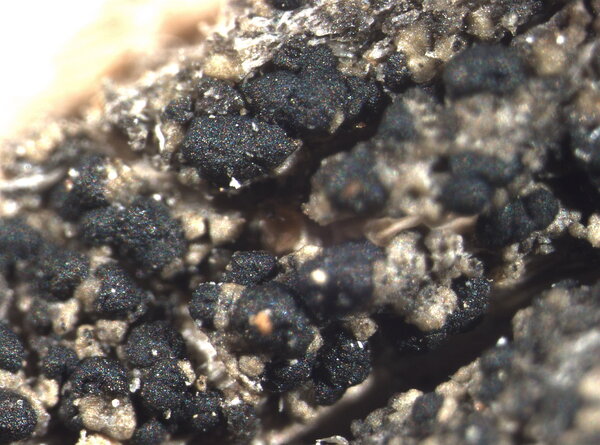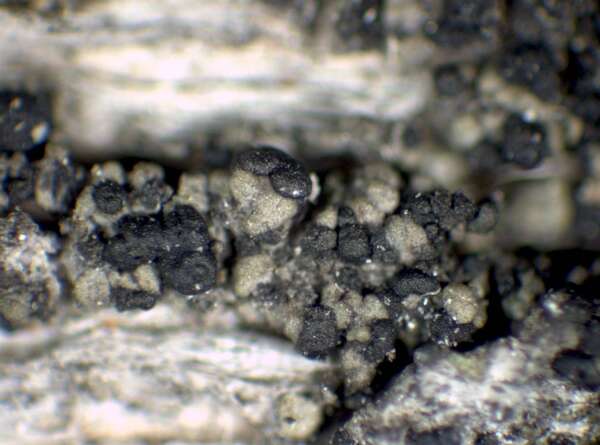Micarea misella (Nyl.) Hedl.
Bih. K. Svenska Vetensk.-Akad. Handl., 3, 18: 78, 88, 1892. Basionym: Lecidea anomala f. misella Nyl. - Lichenes Scand.: 202, 1861.
Synonyms: Biatora misella (Nyl.) H.G. Falk; Lecidea asserculorum sensu Th. Fr. non Ach.; Lecidea asserculorum var. intermedia B. de Lesd.; Lecidea globularis (Nyl.) Lamy; Lecidea misella (Nyl.) Nyl.; Micarea globularis (Nyl.) Hedl.
Distribution: N - Frl, TAA (Thor & Nascimbene 2007, Nascimbene & al. 2007b, 2008c, 2022), Lomb, Lig. C - Tosc (Ravera & al. 2016), Abr (Nimis & Tretiach 1999), Sar. S - Bas (Puntillo & al. 2012), Cal (Puntillo 1996).
Description: Thallus crustose, usually endosubstratic and poorly evident, sometimes thinly episubstratic and consisting of white to pale green-grey, ecorticate, convex granules. Apothecia micareoid, black (rarely pale in shade-forms), sessile, sometimes almost stalked, 0.1-0.3 mm across, with a strongly convex, epruinose disc, and a poorly developed, usually indistinct proper margin. Proper exciple thin, dark brown, K+ violet, of very narrow (<1 µm), radiating, branched and anastomosing hyphae; epithecium brownish green, K+ violet, C+ violet, N-; hymenium colourless or greenish in upper part, 25-35 µm high; paraphyses scarce, sparingly branched except near apices, <1 µm thick at mid-level, the apical cells c. 1.5 µm wide; hypothecium colourless and K-, or pale green and K+ violet, 45-70 µm high. Asci 8-spored, clavate to cylindrical-clavate, with an unstained wall and a K/I+ blue outer layer and apical dome, the latter with a non-amyloid, cylindrical axial mass. Ascospores 1-celled to rarely 1-septate, hyaline, ovoid to ellipsoid, 6-10 x 2-3.5 µm. Pycnidia immersed or emergent-stalked, 0.07-0.2 mm tall, black, the wall greenish brown, K+ violet. Conidia 1-celled, of 2 types: a) mesoconidia, 3.5-5 x 1.5-(1.7) µm, produced in emergent pycnidia; ii) microconidia, 3.8-6 x 0.6-0.8 µm, produced in immersed pycnidia. Photobiont micareoid, the cells 4-7 μm wide. Spot tests: thallus K-, C- or C+ faintly red, KC- or KC+ faintly red, P- (reactions best observed in thick microscopic sections). Chemistry: variable amounts of gyrophoric acid in thallus, Sedifolia-grey pigment in apothecia and pycnidia.Note: a cool-temperate to circumboreal-montane species found on rotting wood, more rarely on acid bark; most common in the Alps, but also occurring throughout the Apennines.
Growth form: Crustose
Substrata: bark and lignum
Photobiont: green algae other than Trentepohlia
Reproductive strategy: mainly sexual, or asexual by conidia and thalloconidia
Commonnes-rarity: (info)
Alpine belt: absent
Subalpine belt: rather rare
Oromediterranean belt: absent
Montane belt: rare
Submediterranean belt: extremely rare
Padanian area: absent
Humid submediterranean belt: extremely rare
Humid mediterranean belt: absent
Dry mediterranean belt: absent

Predictive model
Herbarium samples
Growth form: Crustose
Substrata: bark and lignum
Photobiont: green algae other than Trentepohlia
Reproductive strategy: mainly sexual, or asexual by conidia and thalloconidia
Commonnes-rarity: (info)
Alpine belt: absent
Subalpine belt: rather rare
Oromediterranean belt: absent
Montane belt: rare
Submediterranean belt: extremely rare
Padanian area: absent
Humid submediterranean belt: extremely rare
Humid mediterranean belt: absent
Dry mediterranean belt: absent

Predictive model
| Herbarium samples |
 Index Fungorum
Index Fungorum
 GBIF
GBIF








